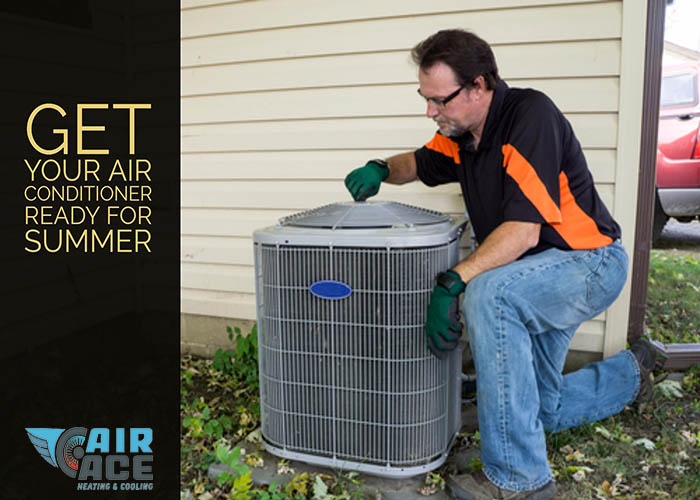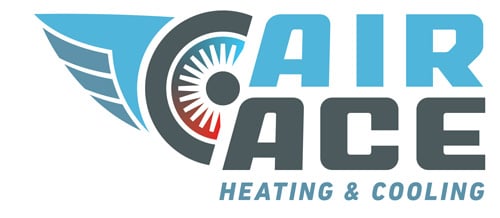Get Your Air Conditioner Ready for Summer

Get Your Air Conditioner Ready for Summer in 6 Simple Steps.
As temperatures rise, being caught in the heat without a functioning air conditioner can be uncomfortable at best and dangerous at worst. The last thing you want on the first hot day of summer is to discover that your central air conditioner isn’t working. Fortunately, with a bit of maintenance, you can ensure your AC is ready to keep you cool. Spring is the perfect time in Central Illinois to prepare your air conditioner for summer.
A central air conditioner consists of an indoor air handler and an outdoor compressor. The condenser unit, typically located outdoors, plays a vital role in cooling your home. After sitting idle during the winter months, your air conditioning unit may have accumulated leaves, dust, and debris. By replacing filters, cleaning the condenser, and performing a few minor checks, you can get your AC unit back in top shape for efficient operation this summer.
Here’s How to Get Your Air Conditioner Ready for Summer in 6 Simple Steps
- Safety First
Before diving into any maintenance tasks, safety should be your top priority.
Turn Off the Power: Start by turning off the circuit breaker for your air conditioning system at your main electrical panel. This prevents any accidental electrical shocks during maintenance.
Disconnect Box: Locate the 240-volt weatherproof disconnect box near your condenser unit. This box contains a lever, fuses, or a circuit breaker to shut off the condenser. Make sure to turn this off as well.
Importance of Safety Precautions
Taking the time to ensure your power is off can prevent serious accidents. Always double-check that the power is off by using a non-contact voltage tester before beginning any work. It’s better to be safe than sorry!
- Clean or Replace the Filters
One of the simplest yet most effective ways to maintain your air conditioning system is by regularly cleaning or replacing the filters.
Frequency: Aim to clean or replace your furnace or air-handler filters at least twice a year, but more often if you have pets or live in a dusty area. Clogged filters restrict airflow, making your AC work harder and reducing efficiency.
Health Benefits: Dirty filters can recirculate dust, allergens, and pollutants into your home, negatively impacting indoor air quality. Using high-efficiency particulate air (HEPA) filters can significantly improve air quality, especially for allergy sufferers.
How to Replace Filters:
Turn Off the System: Ensure the AC is off before changing the filters.
Locate the Filter: Find the filter compartment in your air handler or furnace.
Remove the Old Filter: Take out the old filter, noting its size and orientation.
Insert the New Filter: Place the new filter in the same orientation as the old one, ensuring it fits snugly.
- Clean the Air Conditioner’s Condenser Coils
Cleaning the condenser coils is crucial for maintaining efficiency. Dust and debris can accumulate on the coils, causing the unit to work harder and consume more energy.
Inspect the Unit: C
Coil Cleaning Steps:
Turn off the power to the unit as mentioned earlier.
Remove the side and top panels or protective grilles from the condenser unit.
Use a refrigerator coil brush or a soft brush attached to a vacuum to gently clean the coils. Be careful not to damage the delicate fins.
After cleaning the coils, check for any signs of rust or corrosion, which may indicate a need for professional service.
Why Coil Cleaning Matters:
Dirty coils can lead to higher energy bills and reduced cooling efficiency. Regular cleaning not only helps your unit run smoothly but can also extend its lifespan, saving you money in the long run.
- Clean and Clear Debris
Keeping the area around your condenser unit clear is essential for proper airflow.
Base Clearance: Remove all leaves, grass clippings, and debris from the base of the condenser. A clearance of at least two feet around the unit is ideal.
Drainage: If your air conditioning unit has a drain, ensure it is clear to prevent water buildup, which can lead to mold growth and other issues.
Blower Maintenance: Clean the blower’s fan blades using a vacuum or a damp cloth. Excess water inside the unit should also be cleaned up to prevent rust and corrosion.
Tips for Maintaining Clear Debris:
Consider landscaping around your AC unit to ensure proper drainage and airflow. Keeping shrubs and plants trimmed back also helps prevent debris buildup.
- Check the Coolant Lines
The refrigerant lines running from the air handler to the condenser are essential for cooling. These lines are typically insulated to protect against heat absorption.
Inspect Insulation: Check for any frayed or missing foam insulation. If you find any issues, replace the insulation with new foam sleeves or wrap the lines with foam insulation tape.
Why Insulation Matters:
Proper insulation not only maintains energy efficiency but also ensures that your system operates optimally, allowing for effective cooling throughout your home.
- Test the Unit
After completing the cleaning and maintenance tasks, it’s time to test your air conditioning unit to ensure it’s working correctly.
Testing Steps:
Allow the unit to dry completely.
Turn the thermostat in your home to the off position.
Turn the power back on at both the disconnect box and the main electrical panel.
Switch the thermostat to the cool setting.
Final Reminder:
The air handler or furnace blower circulates chilled, dehumidified air through ductwork to your home’s rooms. If you notice any unusual noises or performance issues during testing, consult a professional HVAC technician to diagnose any potential problems.
Additional Tips for Summer Preparedness
Consider a Professional Tune-Up
While many maintenance tasks can be done DIY-style, scheduling a professional tune-up can identify and fix issues that you may not be able to see. A technician can perform a more in-depth inspection, check refrigerant levels, and ensure everything is working as it should.
Programmable Thermostat Settings
Installing a programmable thermostat can help optimize your cooling schedule. Set it to raise the temperature when you’re not home and cool down the house before you return. This not only keeps you comfortable but can also reduce energy costs.
Seal Ducts and Insulate
Check your ductwork for leaks, which can waste energy and reduce cooling efficiency. Sealing ducts with mastic sealant or professional duct tape can help, and insulating ducts can prevent energy loss in unconditioned spaces.
Keep Vents Clear
Ensure that vents and air returns are not blocked by furniture or curtains. Proper airflow is essential for efficient cooling.
Monitor Energy Usage
Keep an eye on your energy bills, especially in the first few months of summer. If you notice a significant increase, it may be time to investigate further or consult a professional.
Troubleshooting Common Issues
Unit Is Not Cooling Properly
If your air conditioner isn’t cooling effectively, check the thermostat settings first. Ensure it’s set to cool and that the temperature is lower than the current room temperature. If the system still isn’t cooling, it may indicate a refrigerant issue or a dirty air filter.
Strange Noises
Unusual sounds like banging, grinding, or squealing can signal a problem. These noises could indicate loose parts, a failing motor, or other mechanical issues that require professional attention.
Frequent Cycling
If your AC turns on and off frequently, it may be a sign of an oversized unit or an issue with the thermostat. In some cases, this can lead to increased wear and tear on the system, requiring repairs sooner than expected.
Conclusion:
Preparing your air conditioner for summer doesn’t have to be a daunting task. By following these six simple steps and incorporating regular maintenance into your routine, you can ensure your system is ready to keep you cool all season long. Taking the time to maintain your unit not only enhances its performance but also prolongs its lifespan, saving you money in the long run.
Don’t forget to consult a professional for any repairs beyond your comfort level or expertise. With a little effort and attention, you can enjoy a cool, comfortable summer in your home!

